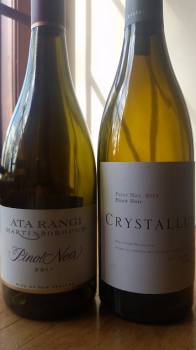SA vs New Zealand Pinot Noir
By Christian Eedes, 3 August 2015

2
Do expectations influence outcomes when it comes to wine ratings? Dana Buys, co-owner of Vrede en Lust, thinks so, arguing for instance that were you to assemble a group of professional tasters and tell them that they were about to taste a line-up of Pinot from New Zealand rather than South Africa, they would necessarily be predisposed to score higher.

The tasting took place at Vrede en Lust and those in attendance included me, James Downes of Shannon Vineyards, Elzette du Preez of De Grendel, Peter-Allan Finlayson of Crystallum, Cathy Marshall of Catherine Marshall Wines, Werner Muller of Iona and Dana and Etienne Buys, Susan Erasmus and Karlin Nel, all of Vrede en Lust.
The wines included in the line-up were as follows:
Flight A: 1. Martinborough Vineyards Marie Zelie Reserve 2010; 2. Ata Rangi 2011; 3. Neudorf Moutere 2011; 4. Mud House Claim 431 Vineyard 2012: 6. Catherine Marshall Reserve 2012
Flight B: 1. De Grendel 2012 – Ceres; 2. Vrede en Lust Artisan Range 2013 – Elgin; 3. Shannon Rockview Ridge 2013 – Elgin; 4. Iona 2013 – Elgin; 5. Catherin Marshall Clay Soils 2013 – Elgin; 6. Akarua Rua 2012
Flight C: 1. Stark-Condé The Grail Pinot Noir 2013 – Overberg; 2. Stark- Condé Postcard Series Round Mountain 2013 – Overberg; 3. Storm Santa Barbara County Duvarita Vineyard 2013; 4. Vrede en Lust 2014 – Elgin; 5. Crystallum Peter Max 2014 – Western Cape; 6. Catherine Marshall Sandstone 2014; 7. Mr P 2014 (Iona) – Elgin
Here’s how my top six turned out:
1.= Ata Rangi 2011 – 93
1.= Neudorf Moutere 2011 – 93
1.= Crystallum Peter Max 2014 – 93
4.= Akarua Rua 2012 – 91
4.= Catherine Marshall Reserve 2012 – 91
4.= Iona 2013 – 91
So the Kiwi stuff did indeed emerge ahead of the South African wines but not by much. What set the former apart was that they tended to show a broader spectrum of both aroma and flavour. Whereas the South African wines exhibited predominantly red fruit, the New Zealand wines had both red and black fruit. Interestingly enough, Finlayson and Marshall were not convinced that black fruit is part of how Pinot Noir ideally expresses itself but I am much more partial to it.
Associated with those black fruit flavours on the New Zealand wines were also relatively high alcohol levels – 13.9% on the Marie Zelie Reserve, 13.8% on the Ata Rangi, 14.5% on the Neudorf, 14% on the Mud House and 14% on the Akarua.
The South African wines, taken as a whole, tended to be quite a bit more slight. If local Pinot was overdone not so long ago, it currently appears that winemakers are in danger of having over-refining their offerings, the result being wines which are pretty but ultimately insubstantial. The New Zealand wines just about all seemed to have a gravitas that still eludes local producers.







Andrew Gunn | 3 August 2015
Within each country there are different styles from the different regions. I visited Central Otago a couple of years ago and found the wines to be largely red fruit driven. No doubt alcohol plays a role, pick riper and you will get more black fruit with lower acidity. It’s a question of taste and I’ll take freshness any day!
Good initiative Dana.
Ryan | 3 August 2015
First the rugby now wine as well! I agree, NZ Pinots are in a league of their own. Is it fair to compare the two countries/wines in this fashion? NZ Pinots have almost become a different varietal where it is not comparable to any other expression of the grape. SA Pinot Noirs in my opinion are more comparable with old world Pinot while the unique combination of weather and terroir in NZ clearly gave them something different from the local Pinot Noirs. Where SA and French Pinots are thin, beefy, leathery, savoury affairs, NZ Pinots have a soft, juicy, fruit driven profile. Is it possible that their winemakers raise the sugar level in wine (naturally) and end up with a softer, juicier wine?
Similarly their Sauv B’s are in a class of their own and almost took on a character of its own. Here there is certain creaminess to the wine where ours are more mineral/tropical in character (generally speaking). Where NZ falls short is with their limited range of wines that they successfully produce. Their Shiraz and Cab Sauvs even Merlots are green and and the ones I tried, not really on par with what can be done with these grapes in South Africa and Australia.
We could just hope for a better result in the World Cup!